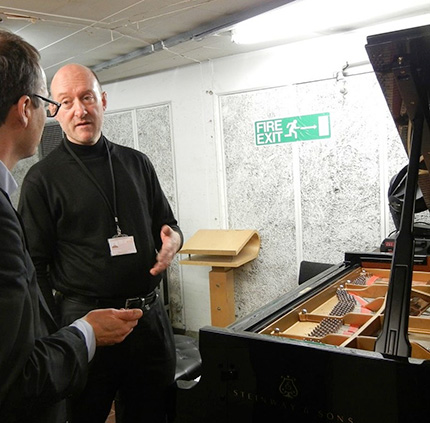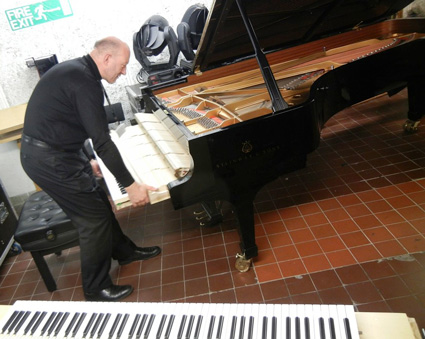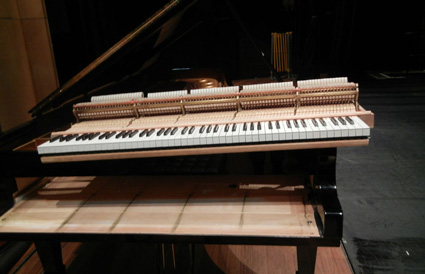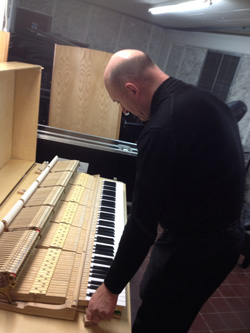More is More and The Art of Perfection – Master Piano Technician Peter Salisbury Turns a Steinway Into Two
Rumors circulating in the recording industry tell of a famous piano technician who has introduced a new innovation: Turn a Steinway D into two! How could this be possible? Piano Street´s Patrick Jovell decided to go to South Bank Centre in London in order to find out.

Peter Salisbury among the instruments at Southbank Centre, London.
The world regards Peter Salisbury as one of the finest piano technicians today. He has worked in the piano industry for more than 33 years and has collaborated with pianists like Brendel, Barenboim, Kissin, Demidenko, Andsnes, Kovacevich and Hamelin. Many of his recording projects have received awards. He also earned the contract for concert tuning and maintenance at London’s South Bank Centre. There, he is responsible for overseeing the widely renowned International Piano Series.
Patrick Jovell: What is a Steinway with Double Action?
Peter Salisbury: It is an instrument specifically prepared for two different sets of actions. These two sets are instantly interchangeable. Most pianists get a feel for the tone through what they hear. Some do not even realise that this was the way the tuners prepared the instrument. For example, pianist John Lill was happy with the instrument he tried when he was here. We had to persuade him to try the second action, and he was utterly shocked at what he heard from the piano! He told us he could not believe it was the same instrument.
I know which of the two actions to show pianists. I know how they play and what they need. Therefore, I have set up certain criteria based on my experience regarding certain pianists. It also matters in which concert venue these pianists will play. We have both the Royal Festival Hall and Queen Elisabeth Hall. An amateur will not hear any difference based on the acoustics in either hall, but the professional knows what will work in each environment.

Peter removing the first action for an instant switch.
My experience has also taught me this: Whenever a pianist is able to sit down and play without thinking about how he or she is doing it, the music just happens. If the pianist overthinks everything, his or her inspiration suffers. We aim to ensure that the tone each pianist wants simply leaps from the instrument. We do not want the performer to need to think unnecessarily about it. I have found that most performers prefer one action of the double Steinway or the other. As long as I have helped the performer find the proper sound by manipulating the voicing and regulation, I have done my job properly!
PJ: How can the Double Action facilitate for the performer?
PS: We have deliberately prepared our set of instruments for any contingency. Through research, we know what all different types of pianists will seek. We have it all covered. Pianists do not sound the same. In that way, the Double Action supports a new way of thinking; you can even choose to play the second half of a recital with a totally different sound. This allows the performer to choose a different sound for different composers. Certain colors for certain types of music become available, creating a platform for those magical moments that are so rare and only happens in great performances.

The second action waiting to be installed.
For example, listen to Benjamin Grosvenors´s latest album that includes piano concertos by Gershwin, Ravel and Saint-Saëns.
We have used different actions in different movements here to get the optimal sound. Benjamin knew which nuances he wanted to get from the instrument. The best part is that he did not have to fight to get it!
Benjamin Grosvenor, Double Action Steinway Recording:
Amazon sampler

First action safely placed in its wooden box.
PJ: Tell me about the instruments you have here at the South Bank Centre. Which instruments have Double Action?
PS: We have ten concert instruments in our fleet here: two Yamaha CFXs, one Bösendorfer and seven Steinway Ds. After contemplating it for years, we decided to go ahead with Double Action and had tremendous success in the Royal Festival Hall. Two Steinways now have Double Action capacity, and we are currently outfitting a third. You might be interested in knowing this; two days from now, in a recital, Krystian Zimerman is going to play the same Double Action Steinway D that you tried out. He will reap the benefits of the Double Action innovation.

Piano Street's Patrick Jovell trying the Double Action Steinway D on stage at Queen Elisabeth Hall.
Comments
Quote ” We aim to ensure that the tone each pianist wants simply leaps from the instrument. We do not want the performer to need to think unnecessarily about it.”
What I’m alluding to is that the tone is not fixed and static on either action, but is a conceptual tone for them to use as a springboard for their own interpretation.
PS.
“An amateur will not hear any difference based on the acoustics in either hall, but the professional knows what will work in each environment.”
Very interesting piece but I am not entirely convinced by the comment above: I am an amateur; I also have an exceedingly good ear. I do wish those operating at the height of classical music would move away from such sweeping statements. I did not choose to pursue music as a career. This does not make me less musical nor less able to differentiate sound with regard to acoustics.
First, let my comment that changing actions between movements of a concerto is all very well for recordings, but It wouldn’t be practical in a live concert setting. So pianists must still do it with their minds, hearts, fingers, wrists, arms and shoulders. Different pianists are known to produce different sound from the same instrument with the same action and hammer set.
Also , why not try this with other brands of pianos? I know of one college in America which purchases a Bosendorfer Imperial concert grand with two actions; one with hard hammers, one with soft hammers.
I’d like to hear what this would do for a Yamaha CXF, a Bechstein, a Petrof, etc.
I saw a Steinway action “swap” as long ago as 2008 at a recital by Vladimir Feltsman in New York. At the intermission the Steinway tech came on stage carrying a big case, pulled the action out of the big Steinway D and put another one in! We had no idea what was happening–perhaps the first action was broken, or not to the taste of the artist?? Much later (several years later) we learned that Mr. Feltsman knew that “the guy” (the Steinway tech) had a piano with two different actions, and since he was playing a Haydn Sonata followed by Moussorgsky’s “Pictures” he decided to try it “for the goof…”
Excellent! This is what this millennium desires. Kudos Peter. Pianists are now going to have swell time.
It would be nice to have a link to a wavefile of the two sounds for comparison.
Isn’t this interesting?
JB
I have done exactly this at home but with a Steingraeber E-272. It is an excellent idea. Surprised it is not used far more often.